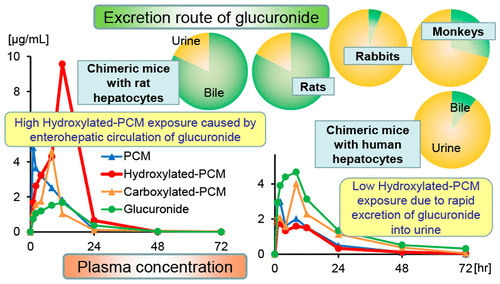当前位置:
X-MOL 学术
›
J. Agric. Food Chem.
›
论文详情
Our official English website, www.x-mol.net, welcomes your feedback! (Note: you will need to create a separate account there.)
Identification of Metabolism and Excretion Differences of Procymidone between Rats and Humans Using Chimeric Mice: Implications for Differential Developmental Toxicity
Journal of Agricultural and Food Chemistry ( IF 6.1 ) Pub Date : 2018-02-15 00:00:00 , DOI: 10.1021/acs.jafc.7b05463 Jun Abe 1 , Yoshitaka Tomigahara 1 , Hirokazu Tarui 1 , Rie Omori 1 , Satoshi Kawamura 1
Journal of Agricultural and Food Chemistry ( IF 6.1 ) Pub Date : 2018-02-15 00:00:00 , DOI: 10.1021/acs.jafc.7b05463 Jun Abe 1 , Yoshitaka Tomigahara 1 , Hirokazu Tarui 1 , Rie Omori 1 , Satoshi Kawamura 1
Affiliation

|
A metabolite of procymidone, hydroxylated-PCM, causes rat-specific developmental toxicity due to higher exposure to it in rats than in rabbits or monkeys. When procymidone was administered to chimeric mice with rat or human hepatocytes, the plasma level of hydroxylated-PCM was higher than that of procymidone in rat chimeric mice, and the metabolic profile of procymidone in intact rats was well reproduced in rat chimeric mice. In human chimeric mice, the plasma level of hydroxylated-PCM was less, resulting in a much lower exposure. The main excretion route of hydroxylated-PCM-glucuronide was bile (the point that hydroxylated-PCM enters the enterohepatic circulation) in rat chimeric mice, and urine in human chimeric mice. These data suggest that humans, in contrast to rats, extensively form the glucuronide and excrete it in urine, as do rabbits and monkeys. Overall, procymidone’s potential for causing teratogenicity in humans must be low compared to that in rats.
中文翻译:

嵌合小鼠鉴定大鼠和人之间丙西酮的代谢和排泄差异:差异发育毒性的意义。
嘧啶酮的一种代谢物羟基化PCM导致大鼠特有的发育毒性,因为它在大鼠中的暴露量高于在兔子或猴子中。当对大鼠或人肝细胞的嵌合小鼠施用丙胺酮时,大鼠嵌合小鼠血浆中羟化PCM的血浆水平高于丙胺酮,并且完整鼠中丙胺酮的代谢谱在大鼠嵌合小鼠中良好地再现。在人类嵌合小鼠中,羟基化PCM的血浆水平较低,导致暴露量低得多。羟基化PCM-葡糖醛酸苷的主要排泄途径是大鼠嵌合小鼠的胆汁(羟基化PCM进入肝肠循环的点)和人嵌合小鼠的尿液。这些数据表明,与大鼠相比,人类会广泛形成葡萄糖醛酸苷并在尿液中排泄,兔子和猴子也一样。总体而言,与大鼠相比,普西米酮引起人致畸的潜力必须低。
更新日期:2018-02-15
中文翻译:

嵌合小鼠鉴定大鼠和人之间丙西酮的代谢和排泄差异:差异发育毒性的意义。
嘧啶酮的一种代谢物羟基化PCM导致大鼠特有的发育毒性,因为它在大鼠中的暴露量高于在兔子或猴子中。当对大鼠或人肝细胞的嵌合小鼠施用丙胺酮时,大鼠嵌合小鼠血浆中羟化PCM的血浆水平高于丙胺酮,并且完整鼠中丙胺酮的代谢谱在大鼠嵌合小鼠中良好地再现。在人类嵌合小鼠中,羟基化PCM的血浆水平较低,导致暴露量低得多。羟基化PCM-葡糖醛酸苷的主要排泄途径是大鼠嵌合小鼠的胆汁(羟基化PCM进入肝肠循环的点)和人嵌合小鼠的尿液。这些数据表明,与大鼠相比,人类会广泛形成葡萄糖醛酸苷并在尿液中排泄,兔子和猴子也一样。总体而言,与大鼠相比,普西米酮引起人致畸的潜力必须低。



























 京公网安备 11010802027423号
京公网安备 11010802027423号